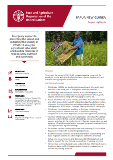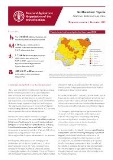Publications

Yemen: DIEM – Data in Emergencies Monitoring brief, round 13
01/2024
This Data in Emergencies Monitoring (DIEM-Monitoring) brief shares the results of a thirteenth-round assessment conducted in October 2023 in Yemen.

Chad: Integrated livestock management to address acute malnutrition in children
01/2024
High levels of food insecurity and acute malnutrition persist in Chad despite investments by government, humanitarian and development actors.

Burkina Faso: DIEM – Data in Emergencies Monitoring brief, round 2
12/2023
This Data in Emergencies Monitoring (DIEM-Monitoring) brief shares the results of a second-round assessment conducted in September and October 2023 in Burkina Faso.

Mali: DIEM – Data in Emergencies Monitoring brief, round 6
12/2023
This Data in Emergencies Monitoring (DIEM-Monitoring) brief shares the results of a sixth-round assessment conducted in September and October 2023 in Mali.

Kenya: Germany’s contribution through the Special Fund for Emergency and Rehabilitation Activities (SFERA) – Anticipatory Action window
12/2023
From late 2020 to early 2023, Kenya experienced a severe and prolonged drought, causing consecutive harvests to fail. Millions of animals died, which would otherwise have provided nourishment and sustained livelihoods.

Safeguarding agricultural livelihoods and food security by scaling up Anticipatory Actions
12/2023
The intensity and frequency of natural hazards and conflicts is increasing, leaving unprecedented levels of humanitarian needs.

Papua New Guinea: Project Highlights – OSRO/TON/200/BEL
12/2023
The Government of Japan contributed USD 1 818 181 to improve the livelihoods and food security of 114 933 households (804 531 people) in Papua New Guinea.

Nepal: Belgium's contribution through the Special Fund for Emergency and Rehabilitation Activities (SFERA)
12/2023
On 3 November 2023, a 6.4 magnitude earthquake struck Nepal, resulting in the loss of lives and property and causing extensive damage to the agriculture sector, the source of livelihoods for many of the affected households.

Global: Project Highlights – OSRO/GLO/908/GER
12/2023
The Government of Germany contributed USD 792 950 to improve the food security and nutrition of cyclone-affected communities in Malawi, Mozambique and Zimbabwe.

Guatemala: DIEM – Data in Emergencies Monitoring brief, round 2
12/2023
This Data in Emergencies Monitoring (DIEM-Monitoring) brief shares the results of a second-round assessment conducted from January to March 2023 in Guatemala.

Global: Project Highlights - OSRO/GLO/203/GER
12/2023
FAO's project entitled "Scaling up Early Warning Early Action (EWEA) for agriculture and food security", funded by Germany aimed to strengthen the resilience of vulnerable people in high risk countries, prevent food crises, and reduce humanitarian needs.

Ukraine: Humanitarian response update - 12 December 2023
12/2023
This document provides an up-to-date summary of the humanitarian situation in Ukraine as well as the response of the Food and Agriculture Organization of the United Nations on the ground, as of 12 December 2023.
.tmb-th600x450.jpg?Culture=en&sfvrsn=86e91eeb_2)
The Democratic Republic of the Congo: Impact of conflict on agriculture, food security and livelihoods in Ituri
12/2023
Marked by more than forty years of conflict, the province of Ituri, in the northeast of the Democratic Republic of the Congo, has experienced massive population displacement and recurrent violence.

FAO in the 2024 Humanitarian Response Plans
12/2023
By the end of 2022, the Global Report on Food Crises recorded the highest-ever levels of acute food insecurity – affecting a quarter of a billion people in 53 countries – in spite of the highest ever levels of funding for humanitarian response.

Anticipating El Niño: Mitigation, preparedness and response plan for Southern Africa, 2023–2025
12/2023
El Niño poses a serious threat to the food security and survival of vulnerable communities around the world.

Palestine: Belgium's contribution through the Special Fund for Emergency and Rehabilitation Activities (SFERA)
12/2023
The escalation of hostilities in Israel and Palestine is drastically affecting all dimensions of food security.

The Sudan: Rapid assessment on the summer season agricultural performance - November 2023
12/2023
This report provides an overview of the Sudan’s summer season agricultural performance as of September 2023.

Northeastern Nigeria: Tom Brown – Local supplementary food for improved nutrition
12/2023
Tom Brown is a supplementary food powder made from a blend of locally available roasted soya beans, groundnut, guinea corn, maize, millet, fish powder and local spices.

Promoting lasting resolutions to land conflicts in the Democratic Republic of the Congo
12/2023
A people-centered approach promoted by the Rome-based Agencies Resilience Initiative

Northeastern Nigeria: Adamawa, Borno and Yobe states. Response overview (November 2023)
12/2023
The latest Cadre Harmonisé analysis (November 2023) indicate that over 26.5 million are projected to be in high acute food insecurity (June-August 2024) across 26 states analysed in Nigeria and in the Federal Capital Territory, including 4.38 million in Adamawa, Borno and Yobe, if appropriate assistance is not provided.
